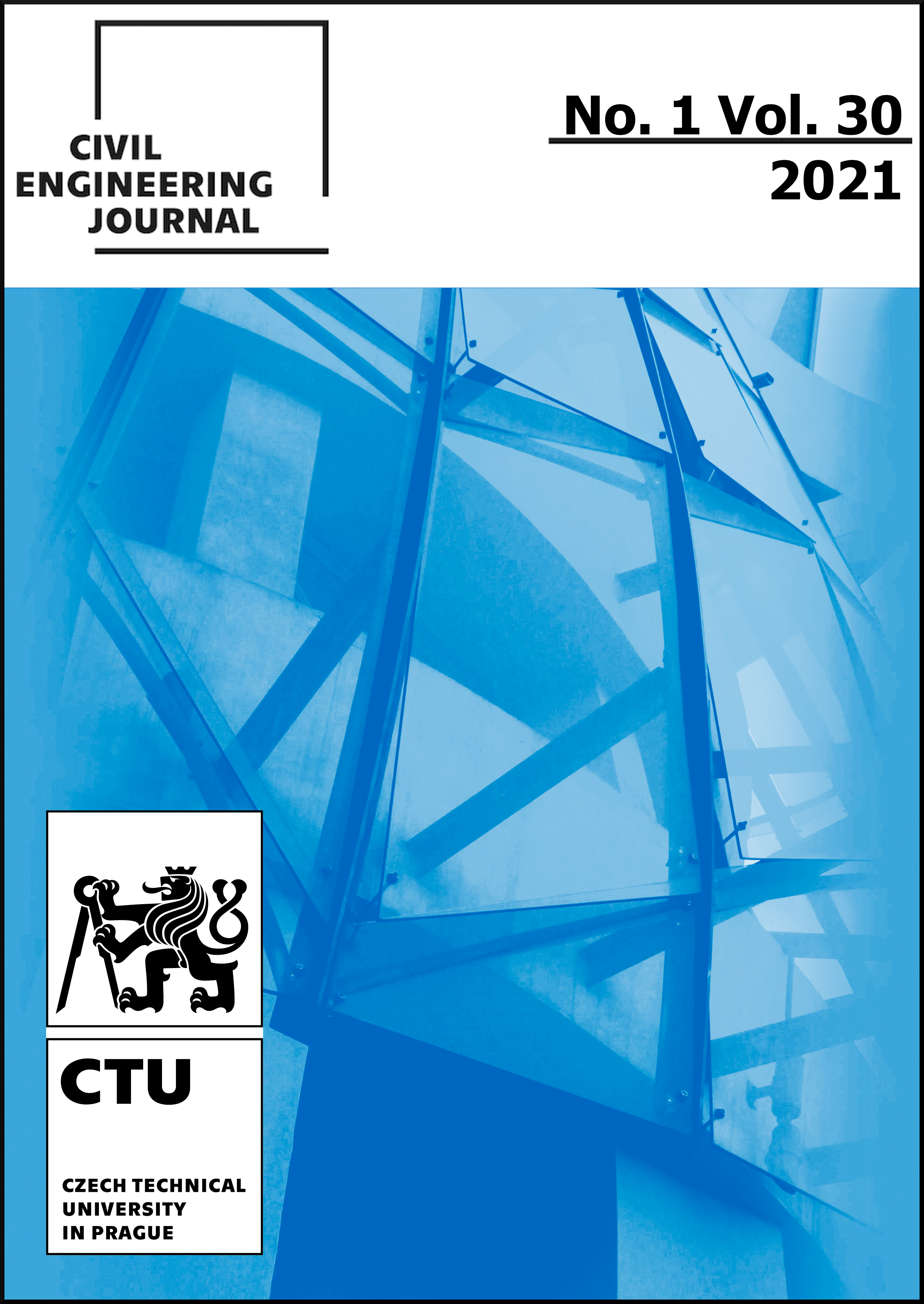GENERATION OF CRACKS IN HIGHWAY EMBANKMENT ON BLACK COTTON SOIL
DOI:
https://doi.org/10.14311/CEJ.2021.01.0006Keywords:
Embankment crack, Black cotton soil, Moisture change, Shrinkage, Tension stressAbstract
This research revealed the crack generation of the highway embankment from the water losing shrinkage of the wet black cotton soil (BCS), which is a type of soil with high swell-shrink potential. The road seepage meter was used to test the permeability of filling materials, which was used to replace BCS. The moisture content and embankment deflection of BCS foundation were measured after the rainy season. Based on the coupled consolidation theory for unsaturated soil, the change in additional tension stress of the embankment induced by water loss shrinkage of BCS was simulated by Abaqus. The results indicated that the rainfall seeped into the foundation through highly permeable refill materials to result in BCS expansion and decrease the embankment strength. After the rainy season, the additional tensile stress caused by water loss shrinkage of BCS induces cracking of highway embankment, and the maximum cracking depth often appears at the shoulder of highway. The deep and wide cracks are easy to appear in the low embankment constructed on a thick BCS foundation under strong evaporation.
Downloads
References
Yitagesu, F.A., van der Werff, H., van der Meer, F., Hecker, C., 2012. On the relationship between plasticity and spectral characteristics of swelling soils: The 3–5 μm wavelength region. Applied clay science, 69: 67-78.
Ola, S.A., 1978. The geology and geotechnical properties of the black cotton soils of northeastern Nigeria. Eng. Geol, 12: 375-391.
Ackroyd, L.W., 1986. Husain, R. Residual and lacustrine black cotton soils of northeast Nigeria. Geotechnique, 36(1): 13-18.
Zhao, P., Xu, Z.X., Tang, L., Zeng, D.L., 2014. Research on the black cotton soil swell-shrink characteristics and the depth of black cotton soil influenced by the atmosphere in Ethiopia. Journal of Railway Engineering Society, 4: 46-50.
Xu, Z.X., Tang, L., Zhang, K., He, X.J., Hou, W.L., 2014. Research on survey methods and engineering properties of black cotton soil of Ethiopian railway. Journal of Railway Engineering Society, 2: 15-18.
Wang, X.Y., Yu, X.L., Song, H., Zhou, Y.D., 2017. Research on the replacement depth and treatment method of black cotton soil in Ethiopian. Highway, 3: 7-12.
Wang, X.F., Wang, Y., Zhang, Y.H., 2012. Design for treatment of subgrade on black cotton soil (BCS). Highway, 9: 46-53.
Gerard, P., Mpawenayo, R., Douzane, M., Debaste, F., 2016. Influence of climatic conditions on evaporation in soil samples. Environmental Geotechnics, 6(6): 323-333.
Irmak, S., Irmak, A., Allen, R.G., Jones, J.W., 2003. Solar and net radiation-based equations to estimate reference evapotranspiration in humid climates. J Irrig Drain Eng, 129: 336-347.
Cheng, Y.Z., Huang, X.M., Li, C., Shen Z.P., 2017. Field and numerical investigation of soil–atmosphere interaction at Nairobi, Kenya. European Journal of Environmental and Civil Engineering, 21(11): 1326-1340.
Research institute of highway ministry of transport., 2007. JTG E40—2007 Test Methods of Soils for Highway Engineering (China Communications Press) 415 PP.
CCC first highway consultants co., LTD., 2015. JTG D30—2015 Specification for design of highway subgrades (China Communications Press), 220 PP.
Research institute of highway ministry of transport., 2008. JTG E60—2008 Field test methods of subgrade and pavement for highway engineering (China Communications Press), 136 PP.
Vardon, P.J., 2015. Climatic influence on geotechnical infrastructure: a review. Environmental Geotechnics, 2(3): 166–174.
Fredlund, D.G., Morgenstern, N.R., 1976. Constitutive relations for volume change in unsaturated soils. Canadian Geotechnical Journal, 13(3): 261-276.
Cheng, Y.Z., Huang, X.M., Li, C., Li, L.Y., 2017. Numerical analysis of crack generation within embankment built on expansive soil foundation. Journal of Southeast University (English Edition), 33(2): 224-229.
Van Genuchten, M.T., 1980. A closed form equation for predicting the hydraulic conductivity of unsaturated soils. Soil Sci Soc Am J, 44: 892–898.
Zheng, J.L., Yang, H.P., 2009. Expansive soil engineering of highway, 170-171 (China communications press) 268 PP.
Downloads
Published
Issue
Section
License
Copyright (c) 2021 Author

This work is licensed under a Creative Commons Attribution-NonCommercial 4.0 International License.
Authors who publish with this journal agree to the following terms:
- Authors retain copyright and grant the journal right of first publication with the work simultaneously licensed under a Creative Commons Attribution License that allows others to share the work with an acknowledgement of the work's authorship and initial publication in this journal.
- Authors are able to enter into separate, additional contractual arrangements for the non-exclusive distribution of the journal's published version of the work (e.g., post it to an institutional repository or publish it in a book), with an acknowledgement of its initial publication in this journal.
- Authors are permitted and encouraged to post their work online (e.g., in institutional repositories or on their website) prior to and during the submission process, as it can lead to productive exchanges, as well as earlier and greater citation of published work (See The Effect of Open Access).











